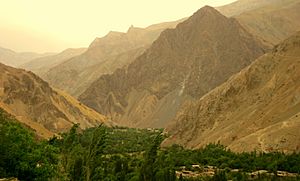Sar-e Pol Province facts for kids
Quick facts for kids
Sar-e Pol
سرپل
|
|
|---|---|

Balkhab District
|
|

Map of Afghanistan with Sar-e Pol highlighted
|
|

Districts of Sar-e Pol
|
|
| Country | |
| District | Sar-e Pol |
| Capital | Sar-e Pol |
| Area | |
| • Total | 16,360 km2 (6,320 sq mi) |
| Population
(2021)
|
|
| • Total | 632,182 |
| • Density | 38.642/km2 (100.082/sq mi) |
| Time zone | UTC+4:30 (Afghanistan Time) |
| ISO 3166 code | AF-SAR |
| Main languages | Dari-Persian, Uzbek and Turkmen |
Sar-e Pol, also known as Sari Pul, is one of Afghanistan's 34 provinces. It is located in the northern part of the country. The province shares borders with several other provinces. These include Ghor and Bamyan to the south. To the east, it borders Samangan. Balkh and Jowzjan are to the north, and Faryab is to the west.
Sar-e Pol province is divided into 7 districts. It has 896 villages. About 632,000 people live here. The population is made up of many different ethnic groups. Most people live in tribal communities. The province was created in 1988. This happened with help from a northern Afghan politician named Sayed Nasim Mihanparast. The main city and capital of the province is Sar-e Pol. In 2021, the Taliban took control of the province. This happened during the 2021 Taliban offensive.
Contents
History of Sar-e Pol
Between the early 1500s and the mid-1700s, the area of Sar-e Pol was ruled by the Khanate of Bukhara. Around 1750, a treaty was signed. After this, the land was given to Ahmad Shah Durrani by Murad Beg of Bukhara. It then became part of the Durrani Empire. The Durranis ruled it, followed by the Barakzai dynasty.
During the three Anglo-Afghan wars in the 1800s and 1900s, the British did not affect this area. Sar-e Pol remained peaceful for about 100 years. This changed in the 1980s with the Soviet–Afghan War.
Recent Events in Sar-e Pol
During the Afghan Civil War, Abdul Rashid Dostum's forces controlled the area. In 1998, the Taliban took over. Aminullah Amin, who was the former governor, was the first high-ranking Taliban member to be captured.
A Swedish-led group called the Provincial Reconstruction Team (PRT) helped with rebuilding. This team had an office and some soldiers in Sar-e Pol. The Afghan National Security Forces (ANFS) grew stronger over the last ten years. They slowly took over security from the International Security Assistance Force (ISAF). The Afghan Border Police (ABP) protects the border with Turkmenistan. The NATO-trained Afghan National Police (ANP) keeps law and order in the rest of the province.
In 2009, the police chief said that many weapons had been collected. Three districts, Sangcharak, Gosfandi, and Sozama Qala, were peaceful. The police chief also said they arrested a Taliban commander, Mullah Nader, and 11 others.
The main dangers for people traveling in Sar-e Pol province are highway robbers and thieves. Also, corrupt police and road dangers are a problem. The Taliban have small groups in the province. But they get more support from nearby provinces. On August 8, 2021, the Taliban took control of the provincial capital again.
Healthcare in Sar-e Pol
Access to clean drinking water has improved. In 2005, 8% of homes had clean water. By 2011, this increased to 15%. The number of births attended by a skilled health worker also increased. It went from 0% in 2005 to 20% in 2011.
Education in Sar-e Pol
The number of people who can read and write has gone up. In 2005, 12% of people aged 6 and older could read. By 2011, this was 23%. School enrollment for children aged 6 to 13 also increased. It went from 22% in 2005 to 46% in 2011.
Geography of Sar-e Pol
Sar-e Pol is a province with many mountains. This is especially true in its southern part. The province covers an area of 16,360 square kilometers. About 75% of the province is mountainous or hilly. The remaining 14% is flat land. The province is divided into 7 districts. It contains 896 villages.
People of Sar-e Pol
As of 2021, the province has about 632,000 people. Sar-e Pol is home to many different ethnic groups. These include Hazara, Uzbek, Tajik, Pashtun, and Turkmen people.
Economy of Sar-e Pol
Mining and agriculture are the main ways people make a living in Sar-e Pol. The Afghan government signed a deal with China National Petroleum Corporation (CNPC). This deal is to develop oil fields in the Amu Darya basin. This project is expected to bring in billions of dollars over 20 years. The deal includes drilling for oil and building a refinery. This will happen in the northern provinces of Sar-e Pol and Faryab. This was the first international oil production agreement for Afghanistan in many decades. Oil production started in October 2012. It was expected to reach 1 million barrels per year by 2013.
On October 5, 2018, Afghan officials signed another contract. This was in Washington, D.C.. It was a 30-year deal with Centar, an investment group. Their company, Afghan Gold and Minerals Co., will invest $56 million. They will explore an area of 500 square kilometers for copper. Mining development is planned to start after the exploration.
Communication services in the province are provided by several companies. These include Afghan Wireless, Roshan, Etisalat, and MTN Group.
See also
 In Spanish: Provincia de Sar-e Pul para niños
In Spanish: Provincia de Sar-e Pul para niños
- Sar-e Pol city
- Sar-e Pol District

